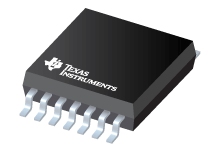Datasheet Texas Instruments TPS61175QPWPRQ1 — Ficha de datos
| Fabricante | Texas Instruments |
| Serie | TPS61175-Q1 |
| Numero de parte | TPS61175QPWPRQ1 |

Convertidor elevador automotriz de alto voltaje 3-A con frecuencia de conmutación programable 14-HTSSOP -40 a 125
Hojas de datos
TPS61175-Q1 3-A High Voltage Boost Converter with Soft-start and Programmable Switching Frequency datasheet
PDF, 1.1 Mb, Revisión: A, Archivo publicado: abr 9, 2016
Extracto del documento
Precios
Estado
| Estado del ciclo de vida | Activo (Recomendado para nuevos diseños) |
| Disponibilidad de muestra del fabricante | Sí |
Embalaje
| Pin | 14 |
| Package Type | PWP |
| Industry STD Term | HTSSOP |
| JEDEC Code | R-PDSO-G |
| Package QTY | 2000 |
| Carrier | LARGE T&R |
| Device Marking | 61175Q1 |
| Width (mm) | 4.4 |
| Length (mm) | 5 |
| Thickness (mm) | 1 |
| Pitch (mm) | .65 |
| Max Height (mm) | 1.2 |
| Mechanical Data | Descargar |
Paramétricos
| Duty Cycle(Max) | 93 % |
| Iq(Typ) | 3 mA |
| Operating Temperature Range | -40 to 125 C |
| Package Group | HTSSOP |
| Rating | Automotive |
| Regulated Outputs | 1 |
| Special Features | Enable,Frequency Synchronization,Light Load Efficiency |
| Switch Current Limit(Min) | 3 A |
| Switch Current Limit(Typ) | 3.8 A |
| Switching Frequency(Max) | 2640 kHz |
| Switching Frequency(Min) | 160 kHz |
| Type | Converter |
| Vin(Max) | 18 V |
| Vin(Min) | 2.9 V |
| Vout(Max) | 38 V |
| Vout(Min) | 2.9 V |
Plan ecológico
| RoHS | Obediente |
Kits de diseño y Módulos de evaluación
- Evaluation Modules & Boards: TPS61175EVM-326
TPS61175 12V Input, 24V Output, 1.2A Evaluation Module
Estado del ciclo de vida: Activo (Recomendado para nuevos diseños) - Evaluation Modules & Boards: TPS61175EVM-588
TPS61175 9V to 18V Input, 12V Output, SEPIC Evaluation Module
Estado del ciclo de vida: Activo (Recomendado para nuevos diseños)
Notas de aplicación
- Simple Power Good circuit using the TPS61175 FREQ pin as referencePDF, 80 Kb, Archivo publicado: mayo 5, 2009
The TPS61175 FREQ pin can provide a 1.229V reference for use in other circuits, including a power good circuit. - Designing a Split-Rail SEPIC With the TPS61175PDF, 493 Kb, Archivo publicado: feb 2, 2010
Often a regulated DC output voltage is needed between the minimum and maximum input voltages of a DC/DC converter, but neither a buck or boost converter in standard configurations is sufficient. However, a boost converter integrated circuit (IC) can be configured to drive a single-ended, primary inductor converter (SEPIC) power stage and provide an output voltage that is between the input voltage - Understanding TPS61175's Pulse-Skipping FunctionPDF, 643 Kb, Archivo publicado: jul 30, 2009
- How to Design a SEPIC Converter With the TPS61175PDF, 586 Kb, Archivo publicado: jun 12, 2009
When a dc/dc converter providing a regulated output voltage between the minimum and maximum input voltage is required, neither a single buck or a boost converter can provide the output voltage. However, a boost converter integrated circuit (IC) can be configured to drive a single-ended, primary-inductor converter (SEPIC) power stage and provide an output voltage that is between the input voltage e - Description Compensating the Current Mode Boost Control LoopPDF, 411 Kb, Archivo publicado: dic 9, 2010
- Extending the Input Voltage Range of the TPS6116x/8x/9x WLED DriversPDF, 124 Kb, Archivo publicado: agosto 12, 2009
The TPS6116x, TPS6118x and TPS6119x WLED driver and TPS6117x boost converter integrated circuits (IC) can operate with different input voltages, one powering the IC itself and the other powering the boost power stage. This application report explains various options on how to use the WLED drivers with split power rails. This allows these LED drivers to be used in applications where the available - Using a portable-power boost converter in an isolated flyback applicationPDF, 535 Kb, Archivo publicado: marzo 11, 2009
- Using the TPS6215x in an Inverting Buck-Boost Topology.. (Rev. C)PDF, 738 Kb, Revisión: C, Archivo publicado: dic 19, 2012
- Q1 2009 Issue Analog Applications JournalPDF, 1.4 Mb, Archivo publicado: marzo 11, 2009
- Design considerations for a resistive feedback divider in a DC/DC converterPDF, 393 Kb, Archivo publicado: abr 26, 2012
- Basic Calculation of a Boost Converter's Power Stage (Rev. C)PDF, 186 Kb, Revisión: C, Archivo publicado: enero 8, 2014
This application note gives the equations to calculate the power stage of a boost converter built with an IC with integrated switch and operating in continuous conduction mode. It is not intended to give details on the functionality of a boost converter (see Reference 1) or how to compensate a converter. See the references at the end of this document if more detail is needed. - IQ: What it is what it isn’t and how to use itPDF, 198 Kb, Archivo publicado: jun 17, 2011
- Performing Accurate PFM Mode Efficiency Measurements (Rev. A)PDF, 418 Kb, Revisión: A, Archivo publicado: dic 11, 2018
When performing measurements on DC-DC converters using pulse frequency modulation(PFM)or any power save mode proper care must be taken to ensure that the measurements are accurate. An accurate PFM mode efficiency measurement is critical for systems which require high efficiency at low loads such as in smart home systems tablets wearables and metering.
Linea modelo
Serie: TPS61175-Q1 (1)
- TPS61175QPWPRQ1
Clasificación del fabricante
- Semiconductors > Power Management > Non-isolated DC/DC Switching Regulator > Step-Up (Boost) > Boost Converter (Integrated Switch)